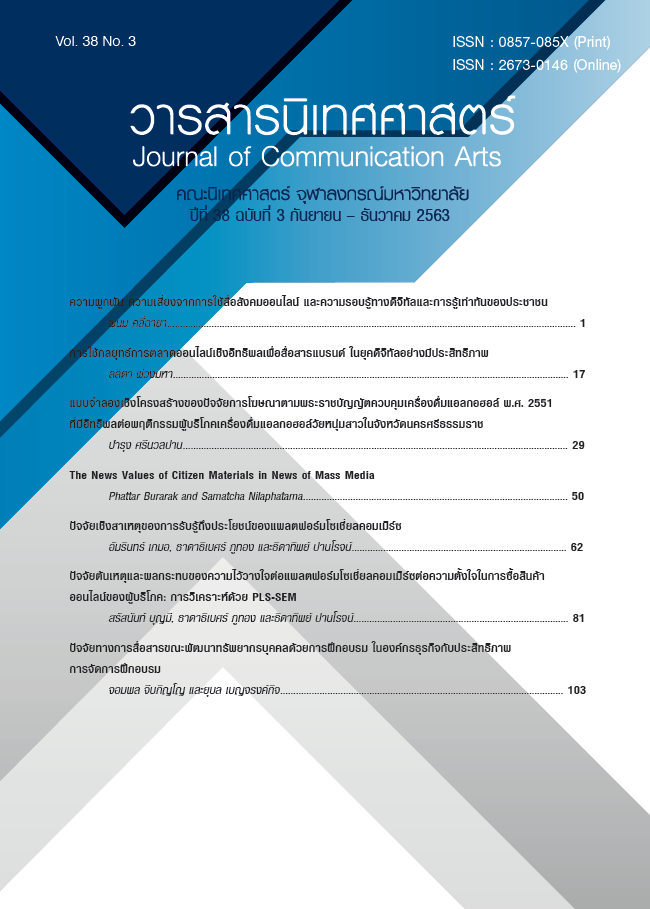Communication Factors in Human Resource Development by In-house Training with Training Management Effectiveness
Main Article Content
Abstract
This research article aims to test a structural equation model of communication factors, which are the qualification and competency of trainers, the training atmosphere management, trainees and the effectiveness of in-house training, generated by the researcher with the existing empirical data, using SPSS Amos program. The data was collected from 520 respondents who are sampling group. The results indicate that the qualification and competency of trainers, and the training atmosphere management variables have no effect towards the effectiveness of in-house training program; however, the trainee variable does. To be specific, if the one standard deviation score of trainee variable increases, the standard deviation score of the effectiveness of in-house training program variable increases at .778. Besides, this structural equation model further explains the variances of the effectiveness of in-house training program variable at 48%.
Article Details
References
กริช อัมโภชน์. (2539). แนวความคิดใหม่ในการฝึกอบรม. สำนักฝึกอบรม สถาบันบัณฑิตพัฒนบริหารศาสตร์.
กาญจนา แก้วเทพ. (2556). สื่อสารมวลชนทฤษฎีและแนวทางการศึกษา. ห้างหุ้นส่วนจำกัดภาพพิมพ์ กรุงเทพฯ
กิตติ กันภัย. (2556). การวิเคราะห์ผู้รับสื่อสารมวลชน. หจก.เหรียญบุญการพิมพ์
ชูชัย สมิทธิไกร. (2554). การฝึกอบรมบุคลากรในองค์การ. กรุงเทพฯ: โรงพิมพ์จุฬาลงกรณ์มหาวิทยาลัย.
ฐณัฐ วงศ์สายเชื้อ. (2561). ทดสอบเครื่องมือวิจัย ค่า Alpha Cronbach ต่ำทุกข้อ แก้ไขอย่างไร. วันที่เข้าถึงข้อมูล 15 มกราคม 2563, แหล่งที่มา https://www.youtube.com/watch?v=bzEJv1FeY54.
ดวงจันทร์ อ่าววิจิตร. (2533). วิธีการฝึกอบรมที่เหมาะสมสำหรับรัฐวิสาหกิจตามการรับรู้ของวิทยากรฝึกอบรม. จุฬาลงกรณ์มหาวิทยาลัย.
ทิพย์สุดา ไชยพฤกษ์. (2552). แรงจูงใจในการเรียนรู้ของบุคลากรสายสนับสนุนในสถาบันอุดมศึกษาของรัฐ เพื่อความเป็นองค์การแห่งการเรียนรู้. มหาวิทยาลัยเทคโนโลยีสุรนารี.
ธีรชาติ ธีรชาติธำรง. (2539). การพัฒนาศักยภาพบุคลากรของกองบัญชาการตำรวจนครบาล : ศึกษาปัจจัยที่มีผลต่อประสิทธิภาพในการฝึกอบรม. มหาวิทยาลัยธรรมศาสตร์.
นงลักษณ์ วิรัชชัย. (2542). โมเดลลิสเรล: สถิติวิเคราะห์สําหรับการวิจัย. กรุงเทพมหานคร: โรงพิมพ์ แห่งจุฬาลงกรณมหาวิทยาลัย.
พีระ จิรโสภณ (2557). ปรัชญานิเทศศาสตร์และทฤษฎีการสื่อสาร หน่วยที่ 11-15. 2557. สำนักพิมพ์ มหาวิทยาลัย
สุโขทัยธรรมาธิราช นนทบุรี
ภัสวลี นิติเกษตรสุนทร. (2557). ประมวลสาระชุดวิชาปรัชญานิเทศศาสตร์และทฤษฎีการสื่อสาร หน่วยที่ 1 - 5. นนทบุรี: โรงพิมพ์มหาวิทยาลัยสุโขทัยธรรมาธิราช.
เมญาพิมพ์ สมประสงค์ (2538). ความคิดเห็นของผู้รับสารที่มีต่อแนวคิดเรื่อง ‘ความเป็นไทย’ ใน ภาพยนตร์โฆษณาที่เน้นความเป็นไทยจากสื่อโทรทัศน์. จุฬาลงกรณ์มหาวิทยาลัย
ยุทธ ไกยวรรณ์. (2556). การวิเคราะห์สถิติหลายตัวแปรสำหรับงานวิจัย. กรุงเทพฯ : สำนักพิมพ์จุฬาลงกรณ์มหาวิทยาลัย.
รุ่งทิพย์ โชตยันดร. (2544). ความสัมพันธ์ระหว่างบรรยากาศองค์การ การรับรู้ความสามารถของตนเอง และการพัฒนาตนเองของพนักงานบริษัทผลิตชิ้นส่วนอิเล็คทรอนิกส์. มหาวิทยาลัยเกษตรศาสตร์.
ลักษณี จรจรัญโสฬส. (2531). การศึกษาความวิตกกังวลของนักเรียนหอพัก และนักเรียนไปกลับของโรงเรียนสุรนารีวิทยา. มหาวิทยาลัยศรีนครินทรวิโรฒ ประสานมิตร.
วิจิตร อาวะกุล. (2540). การฝึกอบรม. กรุงเทพฯ: ศูนย์หนังสือจุฬาลงกรณ์มหาวิทยาลัย.
สมชาติ กิจยรรยง และอรจรีย์ ณ ตะกั่วทุ่ง. (2549). เทคนิคการจัดฝึกอบรมอย่างมีประสิทธิภาพ. กรุงเทพฯ: บริษัท ซีเอ็ดยูเคชั่น จำกัด (มหาชน).
สุดารัตน์ สุมนะกุล. (2533). การติดตามผู้ผ่านการอบรมโครงการฝึกอบรมยุทธศาสตร์การพัฒนาตนเองเพื่อเป็นข้าราชการที่มีประสิทธิภาพของสำนักส่งเสริมศึกษาและบริการสังคมมหาวิทยาลัยธรรมศาสตร์. จุฬาลงกรณ์มหาวิทยาลัย.
สุวัฒน์ วัฒนวงศ์. (2547). จิตวิทยาเพื่อการอบรมผู้ใหญ่. กรุงเทพฯ: ธีระป้อมวรรณกรรม.
สุภมาส อังศุโชติ, สมถวิล วิจิตวรรณา และรัชนีกูล ภิญโญภานุวัฒน์. (2552). สถิติวิเคราะห์สำหรับการวิจัยทางสังคมศาสตร์และพฤติกรรมการศาสตร์: เทคนิคการใช้โปรแกรม Lisrel. กรุงเทพฯ: เจริญดีมั่นคงการพิมพ์.
อรวรรณ ปิลันธน์โอวาท. (2546). การสื่อสารเพื่อการโน้มน้าวใจ. กรุงเทพฯ: สำนักพิมพ์แห่งจุฬาลงกรณ์มหาวิทยาลัย.
Bandura, A. (1977). Self-Efficacy : Toward a Unifying Theory of Behavior Change. Psychological Review, 84, 191–215.
Berlo, D. (1960). The Process of Communication : An Introduction to Theory and Practice. New York: Holt, Rinehart and Winston.
Berlo, D. K., Lemert, J. B., & Mertz, R. J. (1969). Dimensions of Evaluating the Acceptability of Message Sources. Michigan.
Blanchard, N. P., & Thacker, J. W. (2004). Effective training system, strategies, and practice (2nd ed.). Saddle River, NJ: Pearson Prentice.
Bourquin, S. D. (1999). The relationship among math anxiety, math self-efficacy, gender, and math achievement among college student at an open admissions computer institute.
Hair, Jr., J.F., Black, W.C., Babin, B.J., Anderson, R.E., & Tatham, L.R. (2006). Guidelines for Identifying Significant Factor Loadings based on Sample Size. Retrieved December 27, 2019 from https://www.researchgate.
net/post/what_if_my_item_standardized_factor_loading_is_below_07_but_it_is_greater_than_06_rejected_my_manuscript_based_on_this_ground_please_suggest_me
Janis, I. L., & Rife, D. (1959). Persuasibility and emotional disorder. In Personality and persuasibility. Oxford, England: Yale Univer. Press.
Katz E. & Lazarsfeld P.F. (1955). Personal Influence. New York: Random Press.
Kirkpatrick, D. L. (1987). Evaluation of Training. In R. L. Craig (Ed.). Training and Development Handbook : A Guide to Human Resource Development (2nd ed.). New York: McGraw-Hill.
Marple, C. H. (1933). The Comparative Susceptibility of Three Age Levels to the Suggestion of Group versus Expert Opinion. The Journal of Social Psychology, 4(2), 176-186.
McCroskey, J. C., Valencic, K. M., & Richmond, V. P. (2004). Toward a General Model of Instructional Communication. Communication Quarterly, 52, 197–210.
Mitchell, M., & Gilson, J. (1997). Interest and anxiety in mathematics. Journal Announcement, 150(7), 41.
Myers, G. E., & Myers, M. T. (1998). The Dynamics of Human Communication (5th ed.). Singapore: McGraw-Hill.
Schroeder M.A. (1990). Diagnosing and Dealing with Multicollinearity. Western Journal of Nursing Research. 12(2) University of South Carolina College of Nursing, Columbia. Sage Publications Inc.
Tannenbaum, S. I. (1997). Enhancing continuous learning: diagnostic findings from multiple companies. Human Resource Management, 36: 437-452.
Vroom, V. (1970). Industrial social psychology. Management and motivation. New York: McGraw-Hill.


